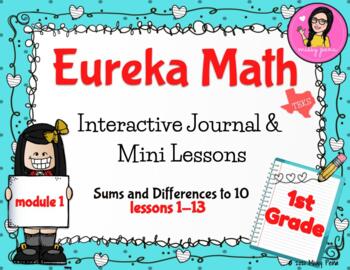Grade 1 Math Module 1 Lessons 1-13 Interactive Journal & Mini Lessons Eureka
Missy Pena
125 Followers
Grade Levels
K - 2nd
Subjects
Resource Type
Standards
CCSS1.OA.A.1
CCSS1.OA.B.3
CCSS1.OA.B.4
CCSS1.OA.C.5
CCSS1.OA.C.6
Formats Included
- PDF
Pages
20 pages
Missy Pena
125 Followers
Also included in
- This resource will be a great addition to your 1st grade math curriculum especially if you are incorporating the Grade 1 Eureka Math program. Module 1 focuses on Sums and Differences to 10. This resource is a condensed version of the daily lessons found in Module 1, Topics A, B, C, D, E, F, G, H, I,Price $15.00Original Price $17.00Save $2.00
Description
This resource will be a great addition to your 1st grade math curriculum especially if you are incorporating the Grade 1 Eureka Math Module 1 program. Module 1 focuses on Sums and Differences to 10. This resource is a condensed version of the daily lessons found in Module 1, Topics A, B, and C (lessons 1-13) of Eureka Math.
Each page includes:
- Objective/I CAN Statement
- Application Problem/RDW (read, draw, write)
- Concept Development
- Helpful Tips
- Problem Set
There are 13 lessons covered in this resource. It is ready to Print-N-Go or use Digitally and is perfect for interactive journals, mini-lessons, reviewing key concepts, homework, or small group instruction. You will also be provided a link for the printable version to download in Google Slides where you can add text boxes and directions to fit your specific needs.
Total Pages
20 pages
Answer Key
N/A
Teaching Duration
3 Weeks
Last updated Aug 26th, 2021
Report this resource to TPT
Reported resources will be reviewed by our team. Report this resource to let us know if this resource violates TPT’s content guidelines.
Standards
to see state-specific standards (only available in the US).
CCSS1.OA.A.1
Use addition and subtraction within 20 to solve word problems involving situations of adding to, taking from, putting together, taking apart, and comparing, with unknowns in all positions, e.g., by using objects, drawings, and equations with a symbol for the unknown number to represent the problem.
CCSS1.OA.B.3
Apply properties of operations as strategies to add and subtract. If 8 + 3 = 11 is known, then 3 + 8 = 11 is also known. (Commutative property of addition.) To add 2 + 6 + 4, the second two numbers can be added to make a ten, so 2 + 6 + 4 = 2 + 10 = 12. (Associative property of addition.)
CCSS1.OA.B.4
Understand subtraction as an unknown-addend problem. For example, subtract 10 – 8 by finding the number that makes 10 when added to 8.
CCSS1.OA.C.5
Relate counting to addition and subtraction (e.g., by counting on 2 to add 2).
CCSS1.OA.C.6
Add and subtract within 20, demonstrating fluency for addition and subtraction within 10. Use strategies such as counting on; making ten (e.g., 8 + 6 = 8 + 2 + 4 = 10 + 4 = 14); decomposing a number leading to a ten (e.g., 13 - 4 = 13 - 3 - 1 = 10 - 1 = 9); using the relationship between addition and subtraction (e.g., knowing that 8 + 4 = 12, one knows 12 - 8 = 4); and creating equivalent but easier or known sums (e.g., adding 6 + 7 by creating the known equivalent 6 + 6 + 1 = 12 + 1 = 13).






